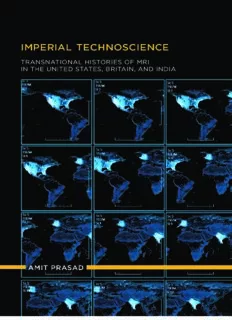
Imperial Technoscience: Transnational Histories of MRI in the US, Britain, and India PDF
Preview Imperial Technoscience: Transnational Histories of MRI in the US, Britain, and India
Imperial Technoscience Inside Technology Edited by Wiebe E. Bijker, W. Bernard Carlson, and Trevor Pinch For a complete list of books published in this series, please see the back of the book. Imperial Technoscience Transnational Histories of MRI in the United States, Britain, and India Amit Prasad The MIT Press Cambridge, Massachusetts London, England © 2014 Massachusetts Institute of Technology All rights reserved. No part of this book may be reproduced in any form by any electronic or mechanical means (including photocopying, recording, or information storage and retrieval) without permission in writing from the publisher. MIT Press books may be purchased at special quantity discounts for business or sales promotional use. For information, please email [email protected]. This book was set in Stone by the MIT Press. Printed and bound in the United States of America. Library of Congress Cataloging-in-Publication Data Prasad, Amit. Imperial technoscience : transnational histories of MRI in the United States, Britain, and India / Amit Prasad. pages cm.—(Inside technology) Includes bibliographical references and index. ISBN 978-0-262-02695-6 (hardcover : alk. paper) 1. Magnetic resonance imaging— History. 2. Medical innovations. 3. Magnetic resonance imaging—United States. 4. Magnetic resonance imaging—Great Britain. 5. Magnetic resonance imaging—India. I. Title. RC78.7.N83P737 2014 616.07'548—dc23 2013028482 10 9 8 7 6 5 4 3 2 1 For Awadh Nandan Prasad and Supriya Guha Contents Acknowledgments ix Introduction 1 1 “Invention” of MRI: Priority Dispute, Contested Identities, and Authorship Regime 15 2 Translating a Dream into Reality: Birth of MRI and Genesis of a “Big Science” 37 3 Marketing Medicine’s “Sports Car”: The United States Becomes the “Center” 59 4 Recovering “Peripheral” History: Genealogy of MRI Research in India 79 5 Three Cultures of MRI: Local Practices and Global Designs 99 Conclusion: Looking Back/Moving Forward 115 Notes 119 References 171 Index 197 Acknowledgments This book has taken a very long time to complete. It owes its existence to the generosity and support of many people. To start with, I would like to thank the MRI scientists in India, Britain, and the United States who not only agreed to be interviewed by me but also shared various documents that belonged to their labs and to their personal collections. In particular, I want to thank Bill Edelstein, Gomathy Gopi- nath, Rakesh Gupta, N. R. Jagannathan, Rama Jayasundar, Paul Lauterbur, Morton Meyers, Peter Morris, and Thomas Redpath. Imperial Technocience has grown out of research I started as a doctoral student. My sincere thanks go to Andrew Pickering for his encouragement and support throughout my research. Andy kept prodding me to show why anybody else should be interested in my topic and kept me on my toes about the emergent aspects of technoscientific practice. Though I was often critical of analyzing technoscience as an open-ended practice, in the end, it helped me articulate the tension between temporal emergence and structural hierarchies. I will never forget Geoffrey Bowker’s mentorship and friendship. Even when we were not in regular touch, I knew I could always count on his support. I also thank Jan Nederveen-Pieterse and Fazal Rizvi, who started as my gurus but who have become very good friends, for their enduring support. And special thanks to the other mentors I was so lucky to have—Michael Goldman, John Lie, Zine Magubane, Paula Triechler, and Charis Thompson. John may not remember, but it was his questioning of my methodology that finally led me to break off my comparative study of two labs, one in the United States and the other in India. Several of my fellow graduate students were not only pillars of strength at that time, but have also continued to be close friends, in particular, Emin Adas, Peter Asaro, Niharika Banerjea, Himika Bhattacharya, Adrian Cruz, Tulsi Dharm- rajan, Indranil Dutta, Aya Ezawa, Ezekiel Flannery, Serife Genis, Saran
Description: